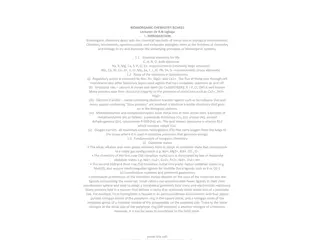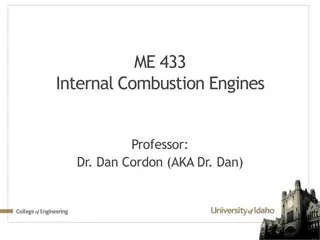Chemistry of f-Block Elements: Lanthanide and Actinide Series Overview
This segment delves into the properties, occurrence, and unique characteristics of the f-block elements, focusing on the Lanthanide and Actinide series. Covering topics such as color, oxidation states, spectral properties, lanthanide contraction, separation methods, and industrial applications of these elements and their compounds, this syllabus offers a comprehensive exploration of the chemistry of f-block elements.
Download Presentation
Please find below an Image/Link to download the presentation.
The content on the website is provided AS IS for your information and personal use only. It may not be sold, licensed, or shared on other websites without obtaining consent from the author. Download presentation by click this link. If you encounter any issues during the download, it is possible that the publisher has removed the file from their server.
Presentation Transcript
Unit III / Sem - II Chemistry of f -Block Elements(Lanthanide and Actinides) Syllabus : Occurrence, properties of the f-block elements, Colour, oxidation state, Spectral and magnetic properties of lanthanides and actinides, lanthanide contraction, Use of lanthanide compounds as shift reagents, compounds of lanthanides, Photoluminescence properties of lanthanide compounds Modern methods of separation of lanthanides and actinides, Applications of lanthanide and actinide compounds in Industries.medicines.
The f-block is of two series: 1. The Lanthanide or Lanthanons or 4f-series, and 2. The Actinide or Actinide or 5f-series. 1. The lanthanide or Lanthanons Series Intervening between barium (Z = 56, Gr.2, i.e. II A) and hafnium (Z = 72, Gr.4, i.e. IVB), there occurs a span of 15 elements called lanthanides or better lanthanons. Lanthanum (Z = 57) and the next fourteen elements cerium to lutetium (Z = 58 to 71), which follow lanthanum, closely resemble one another and form a distinct group, hence these elements are collectively named as lanthanum (Z = 56) itself since this element is the prototype for the succeeding 14 elements. The electronic configurations of these 14 elements are obtained by successive addition of 4f electrons to the lanthanum configuration. For all these elements, outer three main energy levels are incompletely filled. The brief electronic configurations of lanthanons may be given as 2, 8, 18, (2, 6, 10, x), (2) or [Xe] 4fx 5d1 6s2, where x = 0 to 14 for La (57) to Lu (71). As the electrons are added to 4f-orbital, the elements may be called f-elements because in lanthanum, 4f level is still empty; while in lutetium, it is completely filled. The most striking feature of all the 15 elements is that in each of these elements, the three outer elements, the three outer electrons (i.e. 5d1,6s2), occupy exactly the same orbitals. Hence all are present in a single square in the 3rd group and 6th period of the present in a single square periodic table .they occur together, they are difficult to separate, they have similar physical and chemical properties, all show (+3) as the most stable and common oxidation state, etc.
2. The actinide series or the 5f-series begins with actinium and extends through thorium, protactinium and uranium to the artificially prepared elements; neptunium (Z = 93) to lawrencium (Z = 103). These are the Super Heavy Elements(SHE) of the periodic table. Uranium is the last element to occur in nature; hence all the transmutation (TU) elements have been produced synthetically by transmutation of the elements. All these elements have been discovered during the period 1940-1961. Much of the credit of our knowledge of the man-made elements goes to the American Chemist Glenn T. Seaborg and to the University of California. Berkeley. These man-made elements present beyond uranium in the periodic table called transuranic (TU) elements present ,along with Ac, Th, Pa, and U are all present in the f-block of the periodic table, in the 3rdgroup and 7thperiod. For them, (n-2) f (i.e. 5f) orbitals are in the process of filling. They Form the second inner transition series called the actinide series, since the first member is actinium (Z = 89). Thus, all of them are inner transition or sub-transition elements and are actinides or better actions. In general, the lanthanons are represented by the symbol Ln and the actinons by An. The two series of elements are characterized by the preferential filling of 4f and 5f orbitals. In many ways, the chemical properties of lanthanons are repeated by the actions. Much of this similarity was useful during early work on actions to predict their properties by analogy to the lanthanons. But at the same time it should be remembered that the actions series is not merely a reply of the lanthanons series. There is a striking uniformity in their properties and the greater diversity in the chemistry of the actions. The several significant differences between the two series are rooted in their differences between the 4f and 5f orbitals. The Actinide or Action Series:
Properties of Lanthanides: 1. Electronic Configuration (Lanthanides): The fifteen elements which constitute the lanthanon series are listed in Table 2.1, along with their detailed electronic configurations. The electronic configuration of lanthanons may be given as 2, 8, 18, (2, 6, 10, x) (2, 6, 1), 2, OR [Xe] 4fx, 5d1, 6s2 where, x = 0 to 14 from La to Lu, (Z = 57 to 71). The electronic structures of elements are commonly established by interpreting the observed emission spectra of elements. But here the spectra are complex; hence it becomes very difficult to establish the correct configurations of lanthanons. Lanthanum follows barium (Z = 56) where barium has electronic configuration [Xe] 6s2. In lanthanum, the next electron goes to 5d (instead of 4f according to Aufbau order: 4f < 5d) the subsequent electrons in the succeeding elements (Ce to Lu), however, enter into 4f orbitals. According to Aufbau principle and Bohr-Bury s scheme, 5d cannot accommodate more than one electron until 4th main energy level is filled to its full capacity. Under such circumstances, the electronic configurations of lanthanons can be: Xenon core, 4fx 5d1, 6s2 .but spectroscopic data does not agree such configurations. The spectroscopic studies reveal that upto La; 4f orbitals have higher energy than 5d. But as soon as atomic number increases by one, at Ce (Z = 58), its energy falls below 5d. Therefore, the successive extra electrons enter 4f orbitals and give rise to the observed configurations: Xenon core 4fx +1 5do, 6s2. Refer Table 2.1 and Fig. 2.1.
At. No. Element Symbol Idealized Electronic structure [Xe] 4fx 5d1 6s2 Observed Electronic Structure 57 Lanthanum La [Xe] 4f0 5d1 6s2 [Xe]4f05d1 6s2 58 59 Cerium Praseodymiu m Ce Pr [Xe] 4f1 5d1 6s2 [Xe] 4f2 5d1 6s2 [Xe]4f2 5d0 6s2 [Xe]4f3 5d0 6s2 60 61 62 63 64 65 66 67 68 69 70 71 Neodymium Promethium Samarium Europium Gadolinium Terbium Dysprosium Holmium Erbium Thulium Ytterbium Lutetium Nd Pm Sm Eu Gd Tb Dy Ho Er Tm Yb Lu [Xe] 4f3 5d1 6s2 [Xe] 4f4 5d1 6s2 [Xe] 4f5 5d1 6s2 [Xe] 4f6 5d16s2 [Xe] 4f7 5d1 6s2 [Xe] 4f8 5d1 6s2 [Xe] 4f9 5d1 6s2 [Xe] 4f10 5d1 6s2 [Xe] 4f11 5d1 6s2 [Xe] 4f 12 5d1 6s2 [Xe] 4f 13 5d1 6s2 [Xe] 4f14 5d1 6s [Xe]4f4 5d0 6s2 [Xe]4f5 5d0 6s2 [Xe]4f6 5d0 6s2 [Xe]4f7 5d1 6s2 [Xe]4f75d1 6s2 [Xe]4f9 5d0 6s2 [Xe]4f10 5d0 6s2 [Xe]4f11 5d0 6s2 [Xe]4f12 5d0 6s2 [Xe]4f135d0 6s2 [Xe]4f145d0 6s2 [Xe]4f145d16s2
In lanthanum, gadolinium and lutetium, 5d receives one electron and thereby maintains the spherical symmetry of 4f orbitals i.e. 4f0,4f7, and 4f14 respectively. All observed configurations may be accounted on the grounds of the enhanced electronic stability that is associated with the half filled (i.e. 4f7) or completely filled (i.e. 4f14) orbitals. Thus, the 4f7and 4f14 arrangements are achieved as soon as possible say, at europium and ytterbium respectively. The comparison of idealized and observed configurations revels that for lanthanons, the problem lies with respect to the presence or absence of a 5d electron. This problem arises, because 4f and 5d have nearly the same energy and distinction between the two is difficult. Further, it should be noted that whether the fundamental configuration is 4fx, 5d1, 6s 2 or 4fx+1, 5d0, 6s2 is of little chemical significance. This is because lanthanons typically form compounds which are ionic and trivalent, where the electronic structures of the ions are the same. Consider the examples; Ce3+ (f1); pr3+ (f2); Nd3+ (f3) etc. for lanthanons, three outermost energy levels are incompletely filled where actual process of filling occurs in (n-2) f orbitals i.e. in 4f orbitals. These 4f electrons in the prepenultimate shell are very well screened from the effects at the outside of the atom by the 5s and 5p electrons. Consequently the 4f electrons do not take part in bonding nor do they play any significant role in the normal chemistry of these elements. Thus they differ from main transition elements, the chemistry of which is essentially governed by filled and unfilled d-orbitals. The octahedral splitting energy of f-orbitals ( 0) is about 1 kJ mol 1 whether the f-orbitals are filled or empty has, therefore only a little chemical significance. The remarkable features of lanthanides, which are restricted to their f-orbital configurations, are their spectra and magnetic properties only. 2. Oxidation States : An oxidation state of an element can be defined as the charge that an atom bears or appears to bear in a compound.
Name Oxidation States +3 +3 Electronic Configuration of Ions M3+ 4f0 5d0 6s0 +2 +4 M2+ M4+ La(57) Ce(58) +2 +3 +4 4f2 5d0 6s0 4f1 5d0 6s0 4f0 5d0 6s0 Pr(59) +3 (+4) 4f2 5d0 6s0 4f1 5d0 6s0 Nd(60) +2 +3 (+4) 4f4 5d0 6s0 4f3 5d0 6s0 4f2 5d0 6s0 Pm(61) +3 Fd 4f4 5d0 6s0 Sm(62) +2 +3 4f6 5d0 6s0 4f5 5d0 6s0 Eu(63) +2 +3 4f7 5d0 6s0 4f6 5d0 6s0 Gd(64) +3 4f75d0 6s0 Tb(65) +3 +4 4f8 5d0 6s0 4f7 5d0 6s0 Dy(66) +3 (+4) 4f95d06s0 4f8 5d0 6s0 Ho(67) +3 4f10 5d0 6s0 Er(68) Tm(69) +3 +3 4f115d06s0 4f12 5d0 6s0 (+2) 4f13 5d0 6s0 Yb(70) +2 +3 4f14 d0 6s0 4f13 5d0 6s0 Lu(71) +3 4f145d06s0
Specifications oxidation states of lanthanons.: The following points illustrate the observed and the anomalous oxidation states of lanthanons. 1. All the lanthanons show the common and most stable +3 oxidation state. This is just corresponding to their position in Group 3rd (IIIB) of the periodic table. 2.Lanthanum, gadolinium and lutetium show only +3 oxidation state whereby they acquire special stability by attaining the configurations 4f0, 4f 7, and 4f 14 corresponding to empty, half-filled and completely filled f-level respectively. La3+ having 4f0, 5d0, 6s0 configuration becomes highly stable as it attains configuration of Xenon. They acquire a special stability (though to a lesser extent) by attaining f 0, f 7 or f 14 configurations corresponding to an empty, half-filled and completely filled level. 3. Europium and ytterbium show +2 stable oxidation states, as they attain half filled (4f 7) and completely filled (4f 14) configurations in dispositive state, respectively. 4. Cerium and terbium show +4 stable oxidation states as they acquire empty (4f 0) and half filled (4f 7) stable configurations in the tetrapositive state respectively. 5. Samarium and thulium show +2 states with 4f 6 and 4f 13 configurations and praseodymium and neodymium show +4 oxidation states with 4f1 and 4f2 arrangements respectively. In (+2) and (+4) states, these metal ions try to approach stable configurations corresponding to half filled, completely filled and nearly empty 4f levels, respectively. 6. The +2 oxidation state of neodymium with 4f 4 configuration, however, cannot be explained by any of the above reasons. 7. Further, it may be noted that the lanthanons do not show the higher oxidation states than those recorded in Table 2.2. 8. The +4 lanthanide ions viz. Ce4+, Pr4+, Tb4+act as the powerful oxidizing agents and Sm2+, Eu2+, Yb2+ etc. act as the reducing agents
Colour and Spectra : (a) Colour Some of the trivalent ions of lanthanides are coloured in the solid state as well as in aqueous solution. These colours are shown in Table 2.3. The colour appears to depend upon the number of f electrons. The colour of ions containing xf electrons is about the same as those with (14-x) f electrons. This shows that the 4f orbitals are the main cause of colour. The absorption bands in the visible region of electronic spectra of rare earth ions in their compounds arise because of the absorption of light in the visible range resulting in the transition of the electrons of the ions from the lower energy f orbitals to the higher energy f orbitals. A rare earth ion thus appears to be of the colour which is complementary to the colour of the light absorbed. This type of change in the arrangement of f electrons due to absorption of light is called f-f transition. Ion Num ber of 4f elect rons 0 1 2 3 4 5 6 7 Colour Ion Number of 4f electrons Colour La3+ Ce3+ Pr3+ Nd3+ Pm3+ Sm3+ Eu3+ Gd3+ Colourless Colourless Green Lilac Pink Yellow Pale pink Colourless Tb3+ Dy3+ Ho3+ Er3+ Tm3+ Yb3+ Lu3+ 8 9 Pale pink Yellow Pale yellow Pink Pale green Colourless Colourless 10 11 12 13 14
(b) Spectra: A remarkable characteristic of the spectra of the tripositive lanthanide ions is the sharpness of the individual bands. Many of these bands are linelike and become even narrower as the temperature is lowered. This is again, due to the fact that the electrons in the 4f orbitals are effectively shielded from the surroundings by the overlying electrons in the 5s and 5p orbitals of the rare earth ions and hence absorption bands arise merely from electronic transitions within the 4f level. Such transitions are more forbidden than d-d transitions of the transition metal ions since 4f electrons of lanthanide ions are much less affected by the ligands electrons than the electrons in the d orbitals of transition metal ions in their complexes. Therefore, the selection rules are more strictly followed for transitions in the compounds of lanthanides than in the compounds of transition metal.
= = Magnetic properties: The La+3, Lu+3, Ce+4, and Yb+2 ions which have for electronics configuration are diamagnetic. The rest of the trivalent lanthanide ions which contain unpaired electrons in the 4 f orbitals are paramagnetic. The magnetic properties of the lanthanides are different from those of the transition elements. In general, the magnetic moments arise from two types of motion of electron. The spin motion of electron around its own axis produces magnetic moment called spin magnetic moment while the orbital motion of electron around the nucleus produces magnetic moment called orbital magnetic moment. The observed magnetic properties of a substance are thus the result of both the spin magnetic moment and the orbital magnetic moment. In the case of compounds of transition elements (d block elements), the electrons of the metal ions interact strongly with the electrons of the ligands (atoms, ions or molecules) surrounding the metal ions. Due to the electric field of the ligands, the orbital motion of the electrons gets restricted and thereby the orbital magnetic moment of these electrons gets almost quenched. The magnetic moment of d block elements thus arises mainly from the contribution of spin motion of the electrons. The simple relationship based on the spin contribution of the electrons,viz.

















































